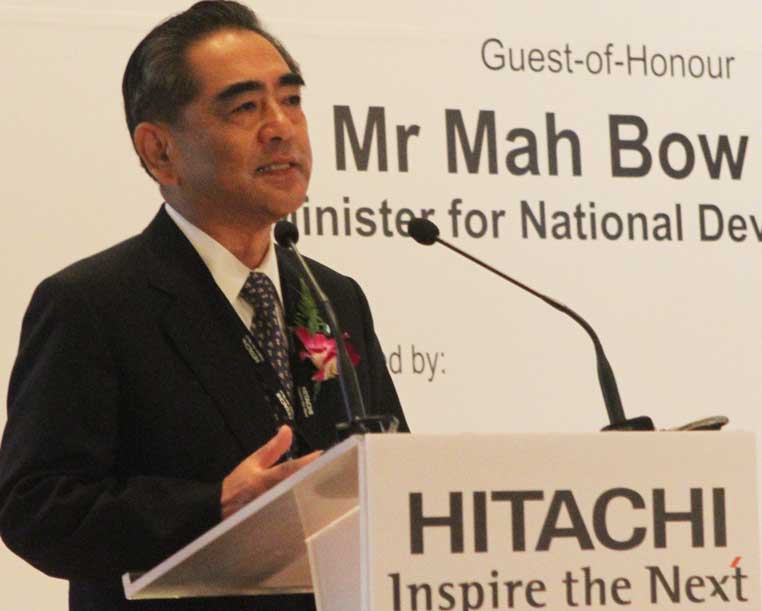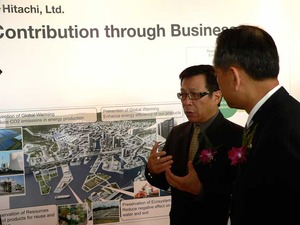Singapore, 13 September 2010. Companies can and should play a significant role in reducing carbon emissions and arresting the steep decline in biodiversity loss. Hitachi is certainly doing its bit.
Hitachi held an Eco Conference in Singapore on 3 September 2010 to address how biodiversity can be conserved through public and private partnerships. According to the United Nations Convention on Biological Diversity (CBD), the target set in 2002 to significantly reduce the current rate of biodiversity loss by 2010 is not being met. As such, the CBD calls for urgent actions by public and private sectors to look into the issues surrounding it.
 Hitachi's Takashi Hatchoji shares their 2025 environmental vision.Hitachi’s Executive Vice President and Group Chief Environmental Strategy Officer Mr Takashi Hatchoji spoke about Hitachi’s “Environmental Vision 2025” set out in 2007 to reduce carbon dioxide emissions by 100 million tons by year 2025.
Hitachi's Takashi Hatchoji shares their 2025 environmental vision.Hitachi’s Executive Vice President and Group Chief Environmental Strategy Officer Mr Takashi Hatchoji spoke about Hitachi’s “Environmental Vision 2025” set out in 2007 to reduce carbon dioxide emissions by 100 million tons by year 2025.
“We reduced the level of CO2 emissions from our corporate activities by 21% in Japan (from fiscal 1990 levels) and reduced emissions by 5% outside of Japan (based on per unit of production, compared with fiscal 2003 levels),” he said.
 Minister Mah (left) visits Hitachi's exhibits and is hosted by Mr Hatchoji (right).Mr Hatchoji later shared with media that around 70% of Hitachi’s carbon emission globally is attributable to the energy requirements for product innovation, while 20% is taken up in infrastructure development. The remaining 10% is used in other segments.
Minister Mah (left) visits Hitachi's exhibits and is hosted by Mr Hatchoji (right).Mr Hatchoji later shared with media that around 70% of Hitachi’s carbon emission globally is attributable to the energy requirements for product innovation, while 20% is taken up in infrastructure development. The remaining 10% is used in other segments.
Hitachi has come a long way, 100 years to be specific, since its inception in 1910 to put carbon emissions in check. And these are the areas where contributions towards global warming prevention is best achieved: nuclear power projects (including nuclear fuel cycle technology to recover and reuse spent fuel), wind turbines, railway systems with hybrid traction, IT platforms, water regeneration, sewage treatment, and recycling of rare metals such as earth magnets.
In 2009, Hitachi scored 53% sales of eco products , an improvement over its original target of 48%. “The eco products are a result of improvement of environment related factors… we hope to increase this target to 100% by 2020,” Mr Hatchoji told Gaia Discovery.
Hitachi is mindful of marine environments when it comes to preservation of ecosystem as well. Its ClearBallast or ballast water purification system using coagulation and magnetic separation help reduce the risk of invasive species in marine transportation. Invasive non-native species is a factor contributing to the threat of ecosystem destruction, leading to downward trends in the population of freshwater animal species (WWF Living Planet Report 2008).
In November 2009, Hitachi Group signed an agreement with China’s National Development and Reform Commission (NDRC) for “friendly collaboration for the establishment of a low-carbon society and resource recycling”. China will get a boost with energy saving and environment conservation through new initiatives in power generation, smart grid, water treatment, water recycling and urban transportation.
Singapore saw the setting up of a Centre of Excellence in April 2010, the hub of Hitachi’s Social Innovation Business in Asia. This will see the development of advanced technologies and solutions such as smart grids, water treatment, security and urban transportation.
“Hitachi remains dedicated to the future of Asia in realising an environmentally sustainable society through our products and services which embodies our commitment to global environmental conservation now and into the next century,” said Mr Hatchoji.
Managing Through Measurement
At the conference, the audience was reminded that businesses today exist in a natural resource and carbon constrained world. Ms Ayako Kohno of CSR Management Sector, Hitachi Chemical shared that one of their three pillars of sustainable development is ecological balance, which has to be balanced with economic growth and social progress.
Hitachi Chemical is engaged in an Ecosystems Services Review (ESR), which is a structured method to manage business risks and opportunities arising from the company’s dependence and impact on ecosystems. Hitachi is part of the World Business Council for Sustainable Development (WBCSD) - a CEO-led, global association of some 200 companies that tackle business with sustainable development.
“We can only manage what we measure,” says Ms Kohno. At the moment, Hitachi’s production of copper-clad laminates in Shomodate Works in Ibaraki, Japan is undergoing the Ecosystems Services Review.
Hitachi Chemical is also road testing a new corporate Ecosystem Valuation Initiative or EVI (http://www.wbcsd.org/web/evi.htm). “Business and biodiversity is no longer a luxury or supplementary, it is the corporate strategy for sustainability,” said Ms Kohno. “With ESR & EVI benefits, the company can attain a long-term vision, triple bottom line while meeting business strategy.”
Addressing the audience, guest of honour Mr Mah Bow Tan, Singapore’s Minister for National Development, said, “I am heartened that Hitachi Singapore has taken the step to commit itself to an Environmental Vision 2025, where the company aims to conserve the environment and realize a sustainable society through prevention of global warming, conservation of resources and preservation of ecosystems.”
Minister Mah reminds businesses that biodiversity contributes to “our fundamental well-being” and hopes that more companies will follow Hitachi’s example in preserving Gaia, our mother Earth.